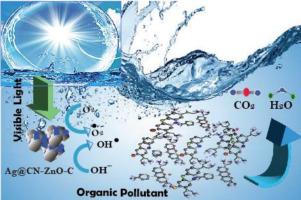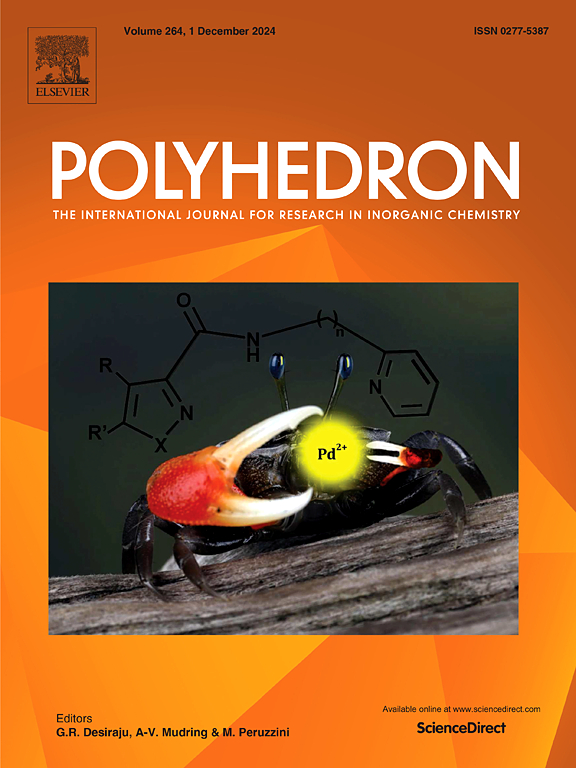Surface-modification of carbon-nitrogen-zinc oxide using biofilm-derived silver nanoparticles for enhanced photocatalytic activities
IF 2.6
3区 化学
Q2 CHEMISTRY, INORGANIC & NUCLEAR
引用次数: 0
Abstract
The small bandgap, particle size, and interface characteristics of nanomaterial surfaces are critical factors that govern their effectiveness in photocatalytic applications. In this study, a heterojunction surface-modified CN–ZnO nanostructure was prepared and tested for its potential to efficiently remove organic dye from aqueous media. The CN–ZnO nanocomposite was synthesized by the controlled thermal decomposition of ZIF-8 in nitrogen (N2) atmosphere, followed by heating in air at 650 °C. Subsequently, the CN–ZnO composite was modified by directly synthesizing Ag@CN–ZnO on its surface, using an electrochemically active biofilm (EAB) as the reducing agent. The as-prepared Ag@CN–ZnO was applied for environmental remediation in the photocatalytic degradation of organic dyes from wastewater. The Ag@CN-ZnO exhibited superior charge separation and a smaller bandgap (~2.93 eV) compared to CN-ZnO (~2.98 eV). The photocatalytic activity for the degradation of organic dyes (methylene blue, methyl orange, Rhodamine B, and p-nitrophenol) was significantly improved compared to pristine CN–ZnO. This enhanced performance is attributed to the highly efficient charge separation produced by increased Ag doping, which facilitated a plasmon resonance shift towards the red end of the spectrum. These results indicate that Ag@CN–ZnO is a promising photocatalyst for addressing dye pollution.

利用生物膜衍生的纳米银对碳-氮-氧化锌进行表面改性以增强光催化活性
纳米材料表面的小带隙、粒径和界面特性是决定其光催化应用效果的关键因素。在本研究中,制备了一种异质结表面修饰的CN-ZnO纳米结构,并测试了其有效去除水中有机染料的潜力。采用ZIF-8在氮气(N2)气氛中受控热分解,然后在650 ℃的空气中加热,合成了CN-ZnO纳米复合材料。随后,以电化学活性生物膜(EAB)作为还原剂,直接在其表面合成Ag@CN -ZnO,对CN-ZnO复合材料进行改性。制备的Ag@CN -ZnO用于光催化降解废水中有机染料的环境修复。与CN-ZnO(~2.98 eV)相比,Ag@CN-ZnO具有更好的电荷分离和更小的带隙(~2.93 eV)。其光催化降解有机染料(亚甲基蓝、甲基橙、罗丹明B和对硝基苯酚)的活性明显高于原始CN-ZnO。这种增强的性能归因于增加银掺杂产生的高效电荷分离,这促进了等离子体共振向光谱的红端移动。这些结果表明Ag@CN -ZnO是一种很有前途的处理染料污染的光催化剂。
本文章由计算机程序翻译,如有差异,请以英文原文为准。
求助全文
约1分钟内获得全文
求助全文
来源期刊

Polyhedron
化学-晶体学
CiteScore
4.90
自引率
7.70%
发文量
515
审稿时长
2 months
期刊介绍:
Polyhedron publishes original, fundamental, experimental and theoretical work of the highest quality in all the major areas of inorganic chemistry. This includes synthetic chemistry, coordination chemistry, organometallic chemistry, bioinorganic chemistry, and solid-state and materials chemistry.
Papers should be significant pieces of work, and all new compounds must be appropriately characterized. The inclusion of single-crystal X-ray structural data is strongly encouraged, but papers reporting only the X-ray structure determination of a single compound will usually not be considered. Papers on solid-state or materials chemistry will be expected to have a significant molecular chemistry component (such as the synthesis and characterization of the molecular precursors and/or a systematic study of the use of different precursors or reaction conditions) or demonstrate a cutting-edge application (for example inorganic materials for energy applications). Papers dealing only with stability constants are not considered.
 求助内容:
求助内容: 应助结果提醒方式:
应助结果提醒方式:


